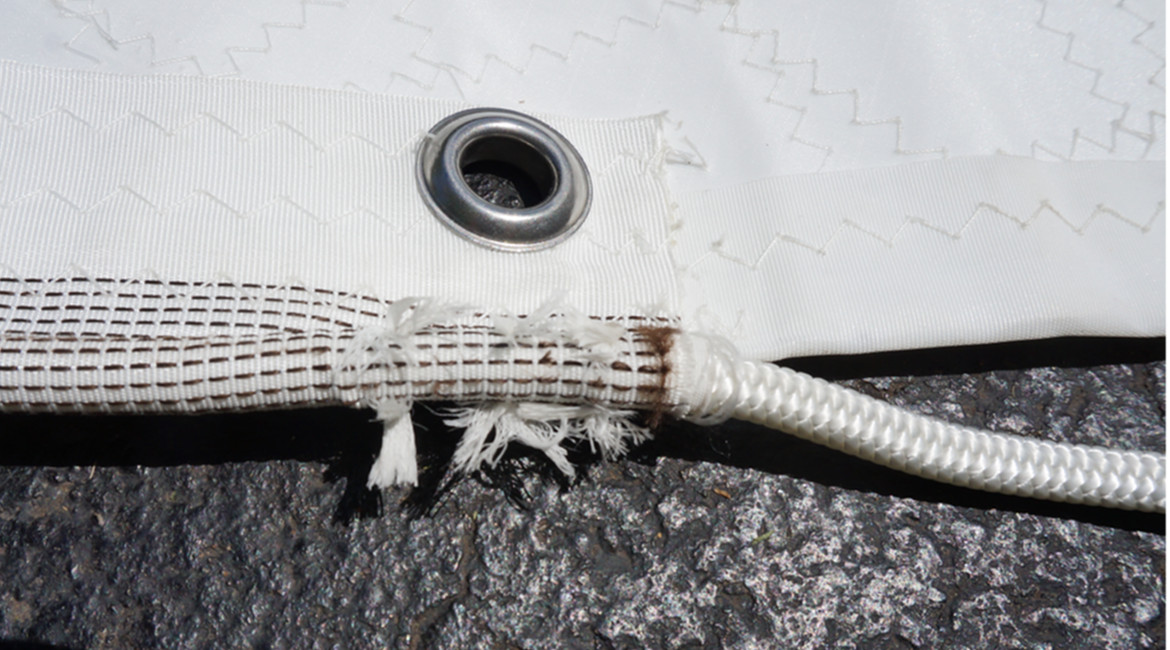Is your sail more than a year old? If so, you should ease the bolt rope to bring the sail back to its design shape. In this article, we explain the importance of the bolt rope and show you how to ease it.
Why the Bolt Rope?
Modern dinghy sails use a rope sewn into the luff of a sail (and the foot for some classes) to provide a strong, aerodynamically efficient attachment to the mast or boom. Bolt ropes distribute the load of the sail, prevent tearing, and prevent leakage of air between the windward and leeward sides of the sail.
Bolt ropes are normally made of polyester, such as dacron, to allow them to stretch.
Bolt Ropes and Sail Shape
The bolt rope affects the shape of the sail via luff tension, which controls the position of maximum draft. Sails are most efficient when the point of maximum draft is about 45% of the distance between the luff and the leech along a chord of the sail. Increasing wind speed moves the point of maximum draft further aft. This requires compensation with sail design and sail controls (i.e., cunningham). See this clip from Captain John for a nice visual explanation.
Sailmakers use the bolt rope to help keep the position of maximum draft stable. They place the bolt rope in the sleeve, stretch the rope, and then sew the rope to the sleeve at the head and foot of the sail. This “pre-load” allows the bolt rope to adjust the length of the luff as the wind changes.
Bolt Ropes Age
Dacron bolt ropes get shorter over time due to age and the effects of repeated stretching. Picture crumpling a piece of paper and then flattening it back out. After crumpling, the flattened paper will be shorter. This same “shrinkage” effect happens to the bolt rope. In a sail, may be noticeable after even one year of use, and will become more severe over additional years.
As the bolt rope gets shorter, it adds luff tension. This will show itself in several ways:
- Wrinkles along the luff
- Sail looks fuller and more “draft-aft”
- Harder to add cunningham
- Harder to hoist sail fully; In extreme cases, you may not be able to lock the halyard
Ease the Bolt Rope
The fix for bolt rope “shrinkage” is simple. Most sailmakers add a tail to the bolt rope at the bottom of the luff. As the rope inside the sleeve gets shorter, you can simply cut the stitching and let some or all of the tail slip in to the sleeve. Here are the steps:

- Examine the sail and find the tail of the bolt rope. The first 3-4” of the sleeve above the tail will have multiple strands of stitching extending through the sleeve and the bolt rope.
- Cut all the pieces of stitching with a sharp scissors or utility knife.
- Pull out the stitching by grasping the cut ends with a pliers. One or more ends will have a knot in them, so find the right direction to pull.
- Verify the bolt rope is loose in the sleeve by pulling on the rope while holding the sleeve. If not loose, cut and remove any stitching you may have missed.
How Much to Ease?
According to many sources, just removing the stitching and freeing the bolt rope at the bottom of the luff is good enough, especially for a very old sail. Don’t be surprised if the entire tail disappears into the sleeve when you hoist the sail.
Top level 470 sailors adjust bolt rope tension often. If you’re really serious, you may want to retain the pre-load in the bolt rope. To do this, you have to re-stitch the bolt rope at the right point in the sleeve. We found instructions on how to do this at the “Stingy Sailor” website.



